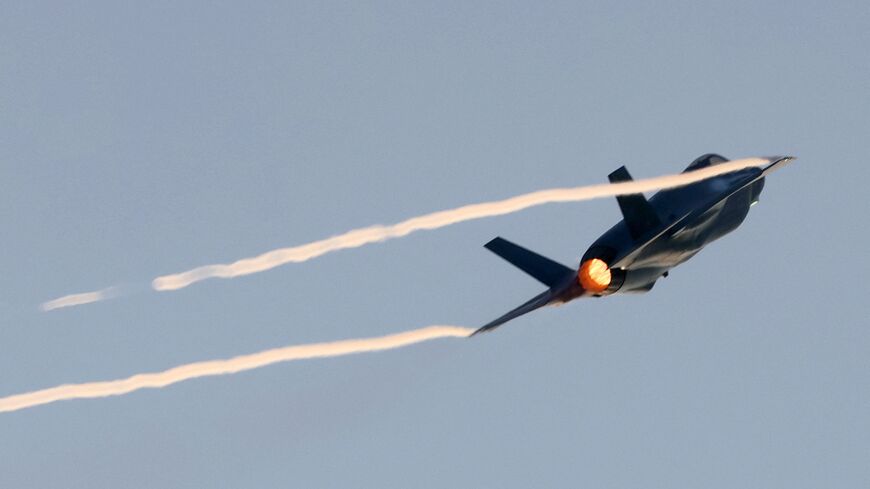Last week, for the first time ever, US Air Force F-35s launched from the USS George H.W. Bush flew several hundred miles over the Mediterranean and linked up with Israeli F-35s to simulate a combined attack on surface-to-air missile batteries in the Negev desert.
As they neared the target, accompanying F-16s and F-15s peeled away to attack as many as ten fourth-plus-generation aircraft posing as the defenders of an imagined enemy airspace.
The first wave successfully cleared the skies, enabling the strikers — three nuclear-capable US B-52 bombers that had taken off from the United States some 16 hours prior, tailed by US and Israeli fighters — to drop more than 100,000 pounds of live munitions on mock strategic targets.
Buoyed by USAF KC-46 refueling tankers operating out of Israel’s Nevatim Airbase, the long-range strikes marked a new apex for the US and Israeli militaries, Air Force Lt. Gen. Gregory M. Guillot, the deputy commander of Central Command (CENTCOM), which oversees all US forces in the Middle East, told Al-Monitor in an exclusive interview this week.
“This was a chance for us to learn from each other,” said Guillot, who oversaw last week's air operations during exercise Juniper Oak 23.2.
“I think in the future, we’ll build a set of common planning and execution standards, which will make further integration even more seamless,” he explained.
Elsewhere over the Mediterranean last week, US and Israeli AH-64 Apaches attacked targets posing a mock threat to naval ships, while combat search and rescue helicopter teams refueled mid-air to "rescue" crew members on the ground in northern Israel.
Members of CENTCOM’s Space Force units also took part with Israeli counterparts for the first time, contributing to precision navigation and missile early warning. While their specific role in the exercise remains classified, Guillot described it as a noteworthy success.
Echoing other US defense officials, the deputy CENTCOM commander stressed that the targets in last week’s drills were not modeled on Iranian ones, but rather simulated “generic threats in the region.”
“It was really to show that we could quickly gather, execute and redeploy forces into the CENTCOM region even when the DoD is also supporting operations in Europe and the Pacific,” he told Al-Monitor. “This wasn't geared towards any one adversary.”
The exercise — the largest and most complex ever undertaken between the US and Israel — marked a key stress test for the Pentagon’s desired ability to surge forces into any region of the world on short notice, rather than depend on an existing military footprint – a principle known as Dynamic Force Employment.
Yet many of the capabilities showcased last week were strikingly similar to those Israel would need to carry out long-range strikes on Iran’s nuclear sites, analysts and former US officials have pointed out.
That prospect, long deemed reckless by policymakers in Washington, was advocated by Israel’s newly sworn-in Prime Minister Benjamin Netanyahu during his previous term in office as an alternative to US diplomatic outreach to Iran, which he saw as insufficient.
US defense officials organized Juniper Oak with counterparts under the previous Israeli government late last year, and Guillot said past concerns about possible unilateral Israeli actions played no role in the planning.
"We knew that we wanted to try to integrate the long-range bombers for their training as well as for ours. And then we already had a bomber Task Force mission scheduled for January," he said. The scheduled presence of the USS George H.W. Bush in the Mediterranean provided a key opportunity, Guillot said.
Yet last week's display came as talks with Iran in Vienna have run out of gas, and US President Joe Biden’s administration appears to be grasping for options to persuade Iranian negotiators back to the table.
Last July, Biden said the US would be willing to use military force as “the last resort” to prevent Iran from obtaining a nuclear weapon.
“Clearly, the United States getting involved in another conflict in the Middle East would be a terrible, terrible situation,” US Sen. Chris Van Hollen (D-Md.) said at an Al-Monitor event in Washington on Tuesday.
“I think the Iranians know very well — and the President has said — that force is the last option. But it is an option,” Van Hollen said.
The White House’s approval for last week’s offensive exercises alongside the Israelis contrasted with the emphasis on defensive military planning when Israel was under US European Command during the Obama administration.
Dan Shapiro, who served as an adviser to Biden’s Iran negotiating team with Tehran until last year, told Al-Monitor, “They’re preparing for a new phase in dealing with Iran outside of the nuclear agreement.”
Shapiro, previously the US ambassador to Israel during the Obama administration, said, “An exercise like this is deterrent, and hopefully it has a restraining effect on certain Iranian decisions.”
Yet Pentagon officials over the past week have avoided saying whether Juniper Oak marks a formal shift to a new posture vis-à-vis Iran’s nuclear program, perhaps in part due to wariness of sending too strong a signal to an adversary that has misread Washington’s intentions in the past.
In 1995, then-CENTCOM commander Gen. Binford Peay ordered amphibious landing exercises on the coast of Oman, triggering a cycle of escalation exploited by hard-liners in both Washington and Tehran.
“It's certainly a concern,” Guillot acknowledged to Al-Monitor. Before last week’s exercise, top defense chiefs in the Middle East were briefed in part to avoid any miscalculations, he explained.
“We very clearly did not have any particular adversary in mind when doing this,” he said.
But concerns about possible escalation peaked over the weekend after suspected Israeli drones exploded at an Iranian military facility in Isfahan. At least two rounds of unclaimed airstrikes, likely launched by Israel, hit suspected Iran-linked convoys in Syria’s southeastern border area with Iraq over the subsequent days.
Al-Monitor asked Lt. Gen. Guillot whether his command was notified of those operations in advance. “All I can tell you is that the US was not involved in either of those strikes,” Guillot said.
CIA director William Burns and US National Security Adviser Jake Sullivan met separately with top security officials in Israel just days before the suspected Israeli strikes, but it remains unclear if Biden administration officials were informed.
One former administration official speaking on condition of anonymity said the Biden administration has long been sympathetic to Israel’s clandestine actions against Iran, and even saw some Israeli operations as benefitting US leverage when JCPOA talks were ongoing.
Whether Washington was forewarned or not, Iranian officials are likely to see the suspected Israeli attacks as linked to Juniper Oak and broader US support for Israel, according to Mick Mulroy, a former senior Pentagon official and CIA paramilitary officer, now an ABC News analyst.
That may well have been the Israeli government’s intent. But as Iran approaches nuclear threshold status, the extent to which Israel’s Arab neighbors are willing to associate with a more assertive posture towards the Islamic Republic remains less clear.
In a tweet on Sunday, Anwar Gargash, a senior adviser to United Arab Emirates President Mohamed bin Zayed, cited Saturday’s drone attack in Isfahan as part of a “dangerous escalation” that is “not in the interest of the region or its future.”
“There is no alternative to dialogue and political solutions to avoid escalation,” Gargash wrote.
CENTCOM plans to brief Arab military officials on "lessons learned" from the Juniper Oak exercise, Guillot told Al-Monitor, "to show how we can quickly bring forces into the region, if necessary, with any of our partners," he said.
"All the feedback I've received has been supportive."
This story has been updated for clarity and to include an additional quote.








